RELATED CONTENT

If 2010 is remembered as the year that “social media” arrived on everyone’s digital radar, 2011 will be the year that social media takes hold to transform digital communications in the health care and vision arenas.
Now generally understood and accepted to be far from a marketing fad that just applies to younger people on the web, social media, today translates to very real relationships and real business opportunities for both customers and patients.
The impact now is referred to by digital marketing gurus as “social e-mail” with an eye toward developing “social return-on-investment.”
The integration of social media connections, like Facebook (
www.facebook.com) and Twitter (
www.twitter.com) with conventional websites (e.g. sign in with Facebook) is the major trend right now. Further, these well known social sites are now being joined by newer social media site variations like Quora (
www.quora.com) and Ning (
www.ning.com) which enable people to create “groups of groups” that they favor—in their cultural and personal worlds as well as their business and health care circles.
The socialization of email, where people open emails and find icons that enable them to connect to the sender via various social channels and “Like” buttons are also facilitating new ways for those connections to geometrically leverage their opinions and preferences. Reviews on Yelp, Yahoo Local or Google Places, are increasingly connecting patients and consumers to real brick-and-mortar businesses.
In fact, the era of ‘Brick + Click’ is upon us. Old stereotypes about social media also no longer apply.
Today, one in five adults 50 to 64 years old are using social media networks regularly, says the Pew Internet & American Life organization, which regularly monitors developments in the digital media world.
While social media use has grown dramatically across all age groups, older users have been especially enthusiastic over the past year about embracing new networking tools. Social networking use among internet users ages 50 and older nearly doubled—from 22 percent in April 2009 to 42 percent in May 2010, according to Pew’s latest report on Older Americans and Social Media.
“Young adults continue to be the heaviest users of social media, but their growth pales in comparison with recent gains made by older users,” explained Mary Madden, senior research specialist and author of the report. “Email is still the primary way that older users maintain contact with friends, families and colleagues, but many older users now rely on social network platforms to help manage their daily communications.”
For eyecare practitioners and retailers, the task of evaluating how and to what degree to become active in social media is also requiring a return visit to their practice websites and their digial presence overall.
Daniel Rostenne, CEO of EyeCare Pro (
eyecarepro.net) an AOA Preferred Provider, specializing in website redesign and search engine optimization, describes how social media is transforming traditional decision methods used by patients to decide when to come into a practice or which practice to visit. A traditional awareness catalyst used to be the Yellow Pages or a practice/office sign. Today’s awareness catalysts, he points out, are often a Google search, asking a Facebook friend for advice on where to get an eye exam, or a positive Yelp review.
At Vision Monday’s CLICK Conference last fall, Nathan Bonilla-Warford, OD, FAAO from Bright Eyes Family Vision Care in Tampa, Fla., stated: “Social media equals real life relationships and those relationships get people in your door and people in your door, buzz about your business, means revenue.”
“Having a website no longer means you are innovative,” stated panelist Kelly Kerksick, OD, director of professional services for Vision Source. “The opportunity now for eyecare businesses is to differentiate ourselves and that is accomplished by how we integrate social media tools.”
Brad Childs, optician and EVP/COO of Eyetique in Pittsburgh summed it up this way: “Social media is a platform to stay in front of your patients. You may ask the question—‘How much time is social networking going to take?’ Well, my response is—‘How much time do you need to invest in your business?’ Because the answer is one and the same. Everything we do is designed to accomplish one thing—get patients in our doors.”
■
maxelrad@jobson.com
1. Expanding Your Expertise and Your Brand
The 13 doctors in 12 Vision Source practices in the Las Vegas area all have practice websites, but the marketing group decided to do more to build the brand in the area.
“When you’re running a PR campaign and there are a dozen offices, you need to send the customers to a centralized place,” said Stephanie Forte, of Forte Creative Media, the public relations firm that works with the regional group. So the group subscribed to EYEHUB’s premiere offering to access a more customizable website, a “portal” which benefits them all.
Now consumers can read bios on each of the doctors, and there’s a map pinpointing all of the Las Vegas Vision Source offices. The PR firm also launched the group’s Facebook page, which supplements the marketing campaigns of individual practices and the regional group. “Most of the offices carry an extensive collection of designer brands, and various offices hold trunk shows,” Forte said. “Anytime we can place a reference to a Vision Source practice in the Las Vegas fashion media, the traffic to the websites increases. That’s one way we can measure that what we’re doing is effective,” she added.
“We wanted patients to feel like these are their hometown eye doctors,” Forte added, and promoting vision screenings in the community and the group’s annual See the Change college scholarship program are ways to do that. Trunks shows and new product arrivals are announced there on Facebook.
The Washington, D.C., Philadelphia, Georgia and Colorado Vision Source regions are also among those that have portal websites. These search-engine-optimized sites help each doctor’s practice show up under multiple keywords on the coveted first page or two of Google searches, said Ally Stoeger, OD, of Burke, Va. See the websites at
www.visionsourcevegas.com,
www.dcareaeyecare.com,
www.eyedoctorsphiladelphia.com,
www.visionsourcega.com and
www.coloradovisionsource.com
2. Saving Time, Not Wasting It

|
|
From streamlining marketing communications to using web-based tools to manage office appointment times and bookings, social media is increasingly a time-saver, rather than a time-waster. Dr. Alan Glazier recently brought to market
Schedgehog.com, a free mobile app for patients, which connects patients with cancelled or rescheduled doctors appointments, making them happy and recouping lost revenue for physicians. |
3. Broadening Your Virtual Circle
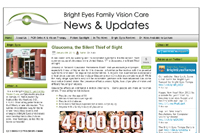 |
|
Dr. Nathan Bonilla-Warford’s practice blog,
www.brighteyesnews.com/ shares vision care news and information about Tampa community happenings. Said Dr. Nate, “Social media allows people to do ‘virtual’ networking—there are only so many chamber of commerce lunches and mixers you can attend.”
|
4. Learning from Colleagues
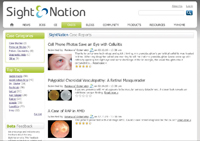
|
|
Sharing information with other professional colleagues in the vision care field has been transformed via the power of social networking and new resources on the web. SightNation (
www.sightnation.com) one of the fastest-growing industry-wide social networking sites for ECPs and optical professionalsm is an open-platform site which enables its “citizens” to exchange ideas and explore the rising trend in social and professional networking. Among these—the ability to share cases and clinical photos, view news articles and features specific to the business and clinical sides of the field, access a robust range of COPE- and ABO-approved continuing education programs. Any registered user on SightNation can start a blog or post a comment in a forum |
5. Leveraging the Power of Reviews
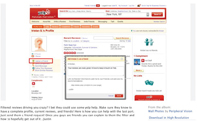
|
|
The phenomenon of patient and customer reviews has intimidated many professionals, but Park Slope Eye’s Dr. Justin Bazan has written extensively about how he manages, to great success, customer review sites like
www.Yelp.com. He cultivates relationships with users and advises other doctors about how to develop review sites to great advantage. |
6. Helping Recruit Talent to Your Practice
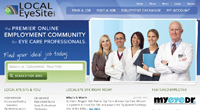
|
|
Local Eye Site (
www.localeyesite.com) points out that social media is revolutionizing recruitment and the ability of optometric practices to find new talent. According to the AMN Healthcare Social Media Survey of Healthcare Professionals, 37 percent of all clinicians surveyed reported using social media for professional networking. The activity on Local Eye Site reflects the dramatic increase in social media to build connections, post job opportunities and connect employers with prospects. |
7. Building Your Community Profile
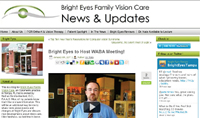
|
|
Expanding your reputation takes on new impact when your business gets involved with others on the local scene. Dr. Nathan Bonilla-Warford posted a short video on his blog, Facebook and Twitter pages, letting people know he was hosting the Westchase Area Business Association meeting. |
8. Enhancing Patients’ Eye Care Education

|
|
Dr. Alan Glazier’s Shade Grove Eye Care & Vision site has leveraged its reputation with patients far beyond its own market in Rockville, Md. with Dr. Glazier’s frequent blog posts and his #badvisiondecision Twitter hashtag. Via his practice’s website,
www.youreyesite.com/ and his practice blog,
youreyesite.net/ Glazier interconnects all of its posts, on vision issues and social media issues via a range of social media tools. |
9. Using ‘Mobile’ to Connect With Your Patients
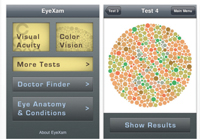
|
|
Some 40 percent of smart phone users are accessing the internet regularly. EyeXam, developed by Nikki Iravani, OD, founder of Global EyeVentures, is described as “The next generation vision awareness device.” EyeXam features a self-guided method for measuring one’s own visual acuity at distance and near, and was developed by two optometrists. The free download EyeXam also includes color vision plates, an Amsler grid, and eye dominance test. A disclaimer on the app reinforces that the EyeXam app does not replace an examination by a licensed professional. The EyeXam was released last April; Vision Source L.P. is the exclusive sponsor of the EyeXam doctor locator |
10. Growing Your Dispensary’s Sales
 |
|
To communicate with patients on large and small issues, there’s no faster way than social media. When Justin Bazan, OD, updates his frame collections or plans to host a block party or art show in his Brooklyn, N.Y. Park Slope neighborhood for his practice, Park Slope Eye, he asks his patients—and the process doesn’t take months, but minutes. Patients can post comments regarding the service they received or send a photo of their updated look in their new eyeglasses. “By using social media, we are developing a base of contacts who value the patient experience,” he said. |
11. Enhancing Your Reputation With Patients
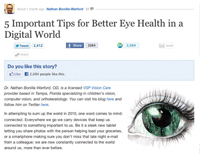
|
|
Dr. Nathan-Bonilla-Warford, an optometrist specializing in children’s vision, computer vision, and orthokeratolog, blogs regularly, which expands his reputation with current and future patients. His recent article for Mashable (
www.mashable.com) a on” 5 Important Tips for Better Eye Health in a Digital World” (
http://mashable.com/2010/11/25/eye-health/) has, to date, received 2,084 Facebook “Likes” and more than 2,400 Tweets and helped readers of this leading social media site better understand how to manage digital vision issues.
■ |